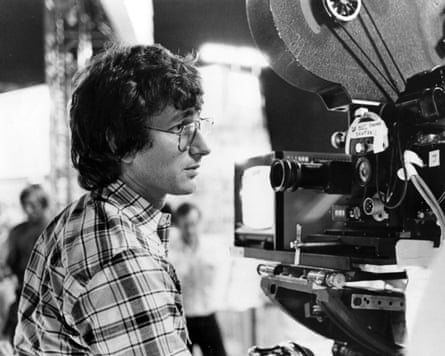The Shark That Changed Cinema Forever: Reflecting on the Legacy of "Jaws" On June 20, 1975, Steven Spielberg’s Jaws made its debut in theaters, forever altering the landscape of modern cinema. Celebrating its 50th anniversary this year, the film is often hailed as the first true blockbuster – a term that would come to define Hollywood in the years to follow. Its cultural impact, both on the movie industry and on audiences around the world, remains immeasurable. From its unforgettable score by John Williams to its pioneering use of suspense, Jaws elevated the thriller genre and became a global phenomenon. The film’s influence continues to be felt today, not just in Hollywood but across the entertainment industry. As the shark that terrified audiences and captivated millions, Jaws is as iconic now as it was five decades ago. A Terrifying Premise: The Birth of a Blockbuster, based on Peter Benchley’s best-selling novel, Jaws, tells the story of a great white shark terrorizing the small island town of Amity, forcing a reluctant police chief, a marine biologist, and a grizzled fisherman to confront the beast. The film’s premise was simple, but Spielberg’s direction transformed it into a thrilling spectacle that had audiences on the edge of their seats.
What set Jaws apart from other monster movies of the time was Spielberg’s ability to combine horror with suspense, creating a sense of dread that stretched beyond the shark’s appearances. Rather than showing the monster in every scene, Spielberg employed a masterful strategy of suggestion and anticipation. This less-is-more approach, exacerbated by mechanical issues with the shark animatronics, ended up being a stroke of genius. The audience’s imagination did much of the work, leaving them terrified of something they couldn’t even fully see. A New Era of Filmmaking: The Birth of the Summer Blockbuster
Before Jaws, movies were largely released year-round, with most blockbuster films reserved for the holiday season. Spielberg’s film flipped that model on its head, creating the concept of the "summer blockbuster"—a season packed with highly anticipated, wide-release films that would dominate box offices. With its record-breaking opening weekend and unprecedented box office returns, Jaws showed that summer could be the most profitable time for movie releases.
The film’s success changed Hollywood forever, encouraging studios to focus on big-budget spectacle films that could pull in massive audiences. As the first major hit of the “blockbuster era,” Jaws set the template for future films like Star Wars (1977), E.T. the Extra-Terrestrial (1982), and Jurassic Park (1993), all of which would go on to further define the modern film industry. In an interview with Entertainment Weekly, Spielberg reflected on Jaws's role in shaping the industry. “We didn’t know it at the time, but Jaws became the benchmark for how to make a movie feel eventful. It set a new precedent for marketing, merchandising, and blockbuster filmmaking." The Impact on Audiences: An Entire Generation Scared of the Ocean. While Jaws’s success had major implications for the film industry, it also had a lasting impact on popular culture. It was impossible to talk about the movie without acknowledging its cultural footprint, especially the way it affected how audiences viewed the ocean. For many, Jaws instilled a deep-seated fear of the sea that would persist for years.

Tourism in seaside towns dropped after the film's release, as people began to associate the ocean with danger rather than recreation. Even today, the phrase “You’re gonna need a bigger boat” has become a part of everyday language, cementing the film’s place in the lexicon of American pop culture. Critics argue that Jaws might have been the first film to elevate “the fear of the unknown” to such a grand scale. Dr. Rebecca Mitchell, a film scholar and author of The Sea and the Silver Screen, commented, “What Spielberg accomplished with Jaws is fascinating. He didn’t just create fear of a predator, but he tapped into the primal fear of the unknown lurking beneath the surface.” The Legacy of Jaws: From Cinematic Craft to Modern-Day Thrillers
While Jaws’s primary genre is horror-thriller, its technical achievements also played a key role in its enduring legacy. John Williams’ iconic score – the ominous two-note theme associated with the shark – remains one of the most recognizable pieces of music in cinema history. Williams’s ability to evoke tension and suspense through music helped redefine how scores could affect the mood of a film.

In addition to its sound, Jaws also pioneered the use of visual storytelling. Spielberg’s innovative camera work, particularly the use of underwater shots and the “shark’s-eye view” perspective, contributed to the sense of unease and danger that permeated the film. Many modern filmmakers cite Jaws as an influence on their own work, including directors like J.J. Abrams, Guillermo del Toro, and even Christopher Nolan, who have all praised Spielberg’s ability to craft tension and suspense. Jurassic Park, another Spielberg classic, shares many of the same principles that made Jaws so successful: limited reveals, unexpected scares, and a constant building of tension. Cultural Criticism: The Shark as a Metaphor for Human Fears
The legacy of Jaws extends far beyond just the horror and thrills. The film’s shark has been interpreted as a metaphor for many of society’s fears, from the unknown dangers lurking beneath the surface of our lives to the darker side of human nature. In an analysis for The New Yorker, critic Adam Gnade argued that Jaws is not just about the terror of a shark but reflects the underlying fears and paranoia of the 1970s in America. “The film came at a time when the nation was grappling with its own sense of disillusionment after the Watergate scandal, the Vietnam War, and the end of the postwar American optimism,” Gnade wrote. “The shark becomes a symbol for those fears, a manifestation of the unseen, lurking dangers that threaten everything we hold dear.”

The Enduring Influence: Jaws at 50 and Beyond. As Jaws reaches its 50th anniversary, it is clear that its legacy continues to influence not just filmmakers but entire generations of moviegoers. The film set the stage for modern cinema, with its groundbreaking approach to suspense, character development, and special effects. It also shaped the way we think about movie marketing, merchandising, and audience engagement—something that still holds true today with global franchise films. For Spielberg, Jaws remains a milestone in his illustrious career, but it also represents the beginning of an era in cinema that would lead to some of the most significant films ever made. Reflecting on the film’s 50-year impact, Spielberg remarked, “I never could have predicted the effect Jaws would have on the industry. It’s a story about overcoming fear and finding the courage to face the unknown, and that’s still something that resonates with people today.”A Shark That Continues to Bite Jaws is not just a film. It’s a cultural event, a blueprint for blockbuster filmmaking, and an enduring legacy of cinematic innovation. As we celebrate its 50th anniversary, Jaws remains a timeless masterpiece, and its influence can still be seen in nearly every major film that follows in its wake. For those who remember the first time they heard those two haunting notes of the iconic score, the terror of Jaws is far from over.
Uphorial.



